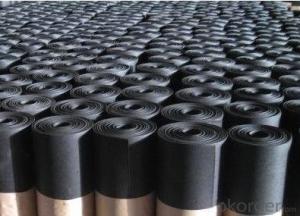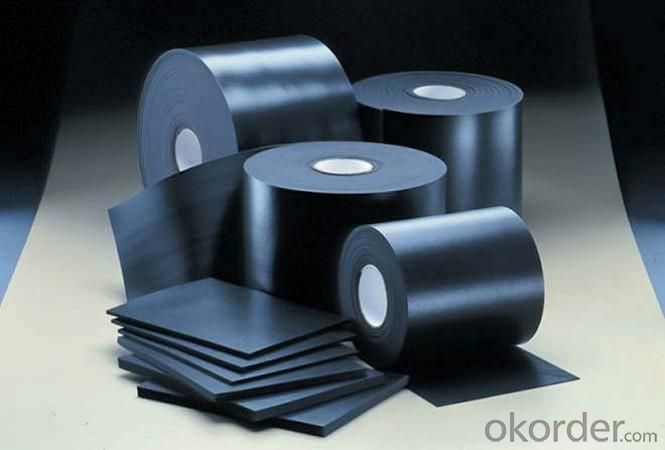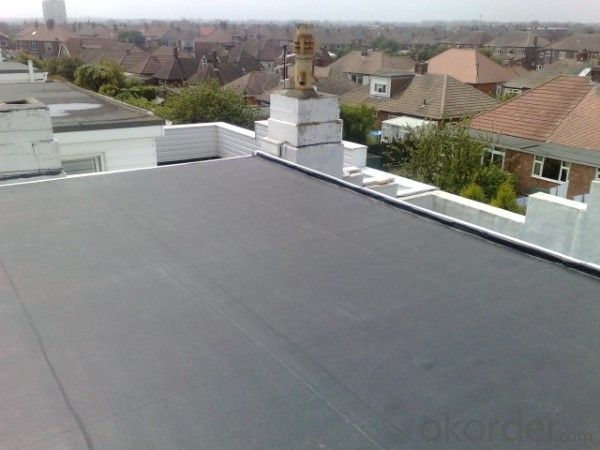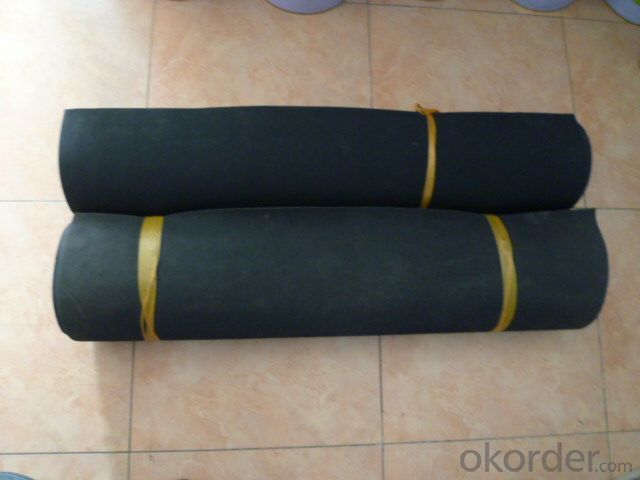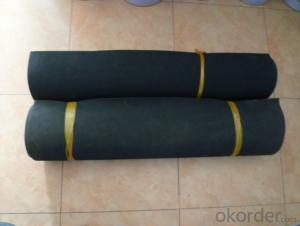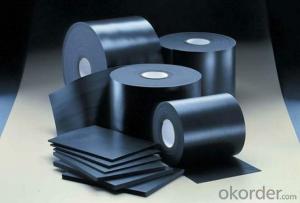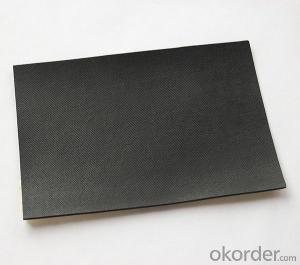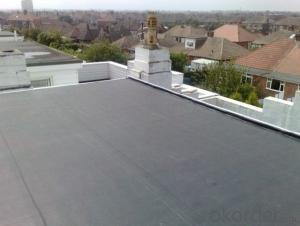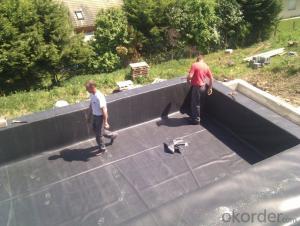EPDM Rubber Waterproof Membrane with Long Width
- Loading Port:
- Shanghai
- Payment Terms:
- TT OR LC
- Min Order Qty:
- 50000 m²
- Supply Capability:
- 5000000 m²/month
OKorder Service Pledge
OKorder Financial Service
You Might Also Like
EPDM Rubber Waterproof Membrane with Long Width
Description Of EPDM Rubber Waterproof Membrane with Long Width:
This waterproof coiled material is of high elasticity with best performance among high polumer waterproof coiled material in the world.It is also the most typical one in the world.Waterproof coiled material made of ternary ethylene-propylene rubber is produced with the use of the most advanced contiuous extrusion and vulcanization technology and related equipments which are specially designed for production of such product.It is good in compactness,without bubble and performance difference in length and breadth,perfomances reach or exceed the demands of GB18173.1-2000 standard.
Main Features of EPDM Rubber Waterproof Membrane with Long Width:
1.EPDM waterproof membrane for bridge engineering waterproof
2.EPDM waterproof membrane for water conservancy projects ,such as river bank,lake dam seepage.
3.EPDM waterproof membrane for the municipal engineering.
4.EPDM waterproof membrane for aquaculture.
Specifications of EPDM Rubber Waterproof Membrane with Long Width:
| Number | Item | Unit | Value | |
| 1 | Size Variation | Thichness | % | ±10 |
| Width | % | ±1 | ||
| Length | % | Allowed negative | ||
| 2 | Breaking tensile strength at normal temperature | Mpa | ≥7.5 | |
| Breaking tensile strength at 70°C | Mpa | ≥2.3 | ||
| 3 | Breaking elongation at normal temperature | % | ≥450 | |
| Breaking elongation at -20°C | % | ≥200 | ||
| 4 | Tear strength | KN/m | ≥25 | |
| 5 | Impermeability(30min) | * | 0.3Mpa no leakage | |
| 6 | Bending at low tempreture | °C | ≤-40 | |
| 7 | Stretch tensor at heating | Elongate | mm | ≤2 |
| Shrink | mm | ≤4 | ||
| 8 | Air oven aging(80°C×168h) | Tensile strength at break retained | % | ≥80 |
| Elongation at break retained | % | ≥70 | ||
| 9 | Anti-alkali | Tensile strength at break retained | % | ≥80 |
| Elongation at break retained | % | ≥80 | ||
| 10 | Nuture weathing at manual simulation | Tensile strength at break retained | % | ≥80 |
| Elongation at break retained | % | ≥70 | ||
Applications of EPDM Rubber Waterproof Membrane with Long Width:
Widely used in roofs, basement, toilet ,swimming pool, and all kinds of industry and civil building waterproofing, reservoir, vivicism, bridge, underground, tunnel and dam waterproofing ,especially to the keystone waterproofing projects which is durability, high corrosion resistance and easy deformation.



IMages of EPDM Rubber Waterproof Membrane with Long Width:




FAQ of EPDM Rubber Waterproof Membrane with Long Width:
1. What are we supplying?
We are specialized in producing Colorful Asphalt Roof Shingle, SBS/APP modified bitumen waterproof membrane, Self adhesive bitumen waterproof membrane, PVC waterproofing membrane, EPDM rubber roofing membrane, Single Component Polyurethane Waterproof Coating, and Spray Polyurea Waterproof Coating
.
2. How Many years experience do we have?
We have been exported to more than 20 countries in the past 15 years.
3. How long do we usually reply your request?
We always reply our customer within 24 hours.
- Q: How thick should a waterproofing membrane be applied?
- The application of a waterproofing membrane is dependent on several factors, including the type of membrane, its intended use, and the project's specific requirements. Typically, the thickness of a waterproofing membrane can vary between 1 and 2 millimeters. When using liquid-applied membranes, it is advisable to apply multiple coats in order to achieve the desired thickness. The number of coats and the thickness per coat will be determined by the manufacturer's instructions and the specific needs of the application. For sheet membranes, the thickness is generally predetermined by the manufacturer and is available in various options, ranging from 0.5 to 2 millimeters. The selection of the appropriate thickness should be based on the project's specific needs, taking into account factors such as the condition of the substrate, expected movement, and required level of protection. In certain instances, local building codes and regulations may also dictate the thickness of the waterproofing membrane. To determine the suitable thickness for a particular application, it is important to consult with a professional waterproofing contractor or refer to the guidelines provided by the manufacturer.
- Q: Can a waterproofing membrane be recycled or disposed of in an environmentally friendly manner?
- Indeed, a waterproofing membrane has the potential to be recycled or disposed of in an environmentally conscious manner. Numerous waterproofing membranes are crafted from recyclable materials like polyethylene or polypropylene, which can be repurposed into new products. The act of recycling these membranes not only diminishes waste, but it also conserves resources and lessens the environmental impact associated with manufacturing fresh materials. In order to recycle a waterproofing membrane, it is crucial to consult local recycling facilities or waste management centers to determine if they accept this specific type of material. Some facilities might have specific guidelines or procedures for recycling membranes, thus adhering to their instructions is of utmost importance. In instances where recycling is not feasible, it is still possible to dispose of the waterproofing membrane in an environmentally friendly manner. Numerous waste management facilities allocate designated areas for construction and demolition waste, providing a proper means of disposing the membrane. These facilities employ methods that minimize the environmental impact of the waste, such as containment and controlled disposal techniques. It is of utmost importance to refrain from tossing the membrane in regular trash or illegally dumping it, as this could harm the environment and contribute to pollution. Proper disposal ensures that any potential pollutants or contaminants within the membrane are appropriately managed, thereby preventing harm to ecosystems and human health. In conclusion, by actively engaging in the recycling or environmentally friendly disposal of a waterproofing membrane, we can contribute to a future that is more sustainable and cleaner.
- Q: Can a waterproofing membrane be used on fiberglass surfaces?
- Indeed, it is possible to utilize a waterproofing membrane on surfaces made of fiberglass. Fiberglass, being non-porous in nature, lacks the ability to absorb or retain water. Nonetheless, it remains vulnerable to water damage if not appropriately safeguarded. By applying a waterproofing membrane onto fiberglass surfaces, an additional barrier is established, thereby obstructing water infiltration and potential harm. This is particularly crucial in areas such as bathrooms, showers, or swimming pools, where fiberglass is commonly employed. The function of the waterproofing membrane is to serve as a safeguarding layer, assuring the preservation of dryness in the fiberglass and the prevention of any prospective water-related predicaments, including leakage, mold formation, or deterioration.
- Q: Does a waterproofing membrane require a primer before application?
- Yes, a waterproofing membrane usually requires a primer before application. The primer helps to improve adhesion between the membrane and the substrate, ensuring a strong and durable bond. It also helps to seal the surface, preventing any moisture or contaminants from interfering with the membrane's performance. Applying a primer before the membrane ensures better effectiveness and longevity of the waterproofing system.
- Q: Can a waterproofing membrane be used on concrete block surfaces?
- Concrete block surfaces can indeed benefit from the application of a waterproofing membrane. These membranes are specifically designed to act as a shield against moisture and water infiltration, which makes them a popular choice for safeguarding concrete block surfaces against water-related harm and leaks. To achieve this, the membranes are either applied as a liquid or in sheet form, bonding to the surface of the concrete blocks and forming a protective layer that prevents water from seeping through. By reducing the risks of water damage, mold growth, and deterioration, the lifespan of the concrete blocks can be extended with the help of this waterproofing membrane. It is crucial to select a membrane that is specifically tailored for concrete block surfaces, and to follow the manufacturer's instructions carefully during installation to ensure optimal results.
- Q: How does a waterproofing membrane handle water pressure from below?
- A waterproofing membrane is designed to handle water pressure from below by creating a barrier that prevents water from penetrating through it. The membrane acts as a protective layer, preventing water from seeping into the structure or area that it is applied to. The membrane is typically made from materials such as rubber, PVC, or bitumen, which have excellent water-resistant properties. These materials are flexible and can stretch to accommodate movement in the structure, ensuring that the membrane remains intact even under dynamic conditions. When water pressure from below is applied, the waterproofing membrane resists the force exerted by the water and prevents it from entering the structure. The membrane is installed in such a way that it covers the entire area that needs protection, ensuring a seamless and continuous barrier against water intrusion. Furthermore, waterproofing membranes often have additional features, such as reinforcement layers or fabric backings, which enhance their strength and durability. These features help the membrane withstand higher water pressures and minimize the risk of leaks or water damage. It is important to note that the effectiveness of a waterproofing membrane in handling water pressure from below depends on various factors, such as the quality of the membrane, proper installation techniques, and the specific conditions of the site. Adequate surface preparation, correct membrane application, and regular maintenance are essential to ensure the long-term performance of the waterproofing system. Overall, a waterproofing membrane is designed to handle water pressure from below by creating a robust barrier that prevents water ingress, protecting the structure or area from potential water damage.
- Q: Can a waterproofing membrane be applied on a sloped surface?
- Yes, a waterproofing membrane can be applied on a sloped surface. In fact, it is often necessary to apply a waterproofing membrane on sloped surfaces to ensure proper drainage and prevent water infiltration. The membrane is designed to adhere to various surfaces, including sloped ones, providing a protective barrier against water penetration.
- Q: Can waterproofing membranes be used on elevator pits?
- Indeed, elevator pits can benefit from the utilization of waterproofing membranes. Given their underground location, elevator pits are susceptible to water infiltration, which can lead to detrimental water damage and leaks. To combat these moisture-related issues, waterproofing membranes offer a highly effective solution by preventing water penetration and safeguarding elevator pits. Typically composed of rubber, polyurethane, or bitumen, these membranes are specifically designed to create a watertight barrier. Through their application on the walls and floor of the elevator pit, they form a seamless and durable protective layer. As a result, this membrane system ensures the maintenance of a dry pit, consequently preventing water damage to the elevator components and ensuring the safe and reliable operation of the elevator.
- Q: Can a waterproofing membrane be used for bridges and overpasses?
- Bridges and overpasses can benefit from the use of waterproofing membranes. These membranes are widely employed in the construction industry to safeguard structures against water infiltration. They are specifically designed to create a barrier between the structure and moisture, effectively preventing water from seeping into the concrete or steel components. The installation of a waterproofing membrane significantly extends the lifespan of these structures by inhibiting corrosion, concrete degradation, and other damages caused by water exposure. Furthermore, these membranes offer protection against other environmental factors such as freeze-thaw cycles, chemicals, and UV radiation. Therefore, it is a commonplace practice in the industry to utilize waterproofing membranes for bridges and overpasses, as it enhances their durability and longevity.
- Q: Are waterproofing membranes resistant to saltwater?
- Yes, waterproofing membranes are generally resistant to saltwater. These membranes are designed to create a barrier that prevents water from penetrating through surfaces such as roofs, walls, or foundations. They are made from materials like rubber, polyethylene, or PVC, which are inherently resistant to the corrosive effects of saltwater. This resistance allows waterproofing membranes to effectively protect structures and surfaces from water damage, even in saltwater environments. However, it is essential to choose a waterproofing membrane specifically designed for saltwater applications to ensure optimal performance and longevity.
Send your message to us
EPDM Rubber Waterproof Membrane with Long Width
- Loading Port:
- Shanghai
- Payment Terms:
- TT OR LC
- Min Order Qty:
- 50000 m²
- Supply Capability:
- 5000000 m²/month
OKorder Service Pledge
OKorder Financial Service
Similar products
Hot products
Hot Searches
Related keywords
